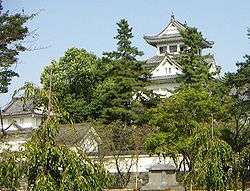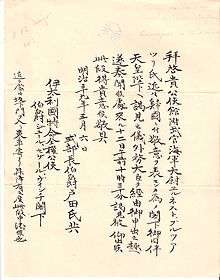Ōgaki Domain
The Ōgaki Domain (大垣藩, Ōgaki-han) was a Japanese domain during the Edo period, located in Mino Province (modern-day Ōgaki, Gifu Prefecture).

History
Historically, the Ōgaki area had been a highly important point of transit from Mino Province to Ōmi Province; it was vital to Saitō Dōsan and later to Oda Nobunaga. In the Edo period, the domain changed hands several times before it was given to the Toda clan, who held it until the Meiji Restoration.

The Ōgaki Domain took part in the Boshin War, first on the side of the Shogunate, and then as one of the components of the imperial army which was at the forefront of the offensive against Aizu and the northern domains.[1]
In the Meiji period, the Toda family of Ōgaki received the rank of viscount (伯爵 hakushaku) in the new kazoku nobility.
List of lords
- Ishikawa clan (Fudai; 50,000 koku)
- Ishikawa Yasumichi
- Ishikawa Ienari
- Ishikawa Tadafusa
- Matsudaira (Hisamatsu) clan (Fudai; 20,000 koku)
- Matsudaira Tadayoshi
- Matsudaira Norinaga
- Abe Nagamori
- Abe Nobukatsu
- Matsudaira (Hisamatsu) clan (Shinpan; 60,000 koku)
- Matsudaira Sadatsuna
- Toda Ujikane
- Toda Ujinobu
- Toda Ujiaki
- Toda Ujisada
- Toda Ujinaga
- Toda Ujihide
- Toda Ujinori
- Toda Ujikane
- Toda Ujimasa
- Toda Ujiakira
- Toda Ujitaka
- Toda Ujihide
In fiction
The Ōgaki domain is the setting for Yamamoto Shūgorō's novel Hanamushiro (translated into English as The Flower Mat).
Further reading
- Yamamoto Shūgorō (1977). The Flower Mat. Translated by Mihoko Inoue and Eileen B. Hennessy. (Rutland, Vt.: C.E. Tuttle Co.)
References
- Yamakawa Kenjirō (1931). Aizu Boshin Senshi. (Tokyo: Tokyo Daigaku Shuppankai) pp. 232-33.